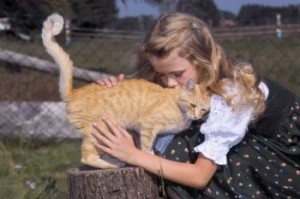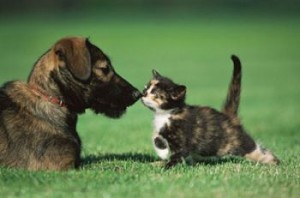Do you know what your cat’s tail is saying to you?
Tails on cats are very expressive. They relay emotions, anticipation, and expectations. The tail can show when a cat is moody, temperamental, frisky, vivacious, and happy.
A cat’s tail when happy or anticipating something pleasant, such as your voice in the morning or wet food for breakfast, will stick straight up in the air. Kitties will often have their tails held upright when greeting people they like or other animals, including kitty pals. A cat may hold his tail up like a little flag when coming to you for food treats or expecting quality time, such as cuddles or light brushing. If your kitty runs up to you with his tail high in the air, take it as a compliment. It is.
A discontented cat or an indecisive cat will twitch his tail or gently wag it. The more the tail wags, the more it indicates discomfort or aggression. The tail can also wag if there is a loss in eyesight or balance, or if a kitty has a high play drive but no specific outlet to direct it to. You may also see your kitty’s tail wag during play, since play mimics hunting. Pain will also cause a cat’s tail to twitch. When the tail turns from a twitch to a wag it indicates that the kitty is more disgruntled or disconcerted. So if you are petting your kitty and his tail starts to twitch at the tip, he is not particularly sure about the attention he is receiving or the manner in which you are petting him. If the twitching turns into wagging, it might be time to stop petting him or to change your approach.
A tail that is relatively in line with the body or parallel to the floor when the kitty is standing, usually indicates s/he is in the middle of a routine, such as walking in a field, or walking from room to room, or to the litter pan.
If your kitty’s tail is tucked tightly around your kitty’s body, your kitty may be cold, may not have a warm and comfy resting place s/he likes—cats like to lie on surfaces that are warm and soft, may be feeling distant or isolated, or may be feeling uncomfortable. Often kitties will position themselves relative to each other where there is a personal distance. If one kitty seems huddled or hunched, with his tail wrapped around his body, there may be disharmony in the kitty dynamics, or your kitty may feel isolated or in pain.
If your kitty’s tail is tucked tightly under his body or tightly against his body, it indicates fear and avoidance. It can also indicate fear due to pain.
If your kitty’s tail becomes fearfully fluffed, it is piloerection and is very similar to our hairs standing up on the back of our necks. Usually this occurs if your cat is fearfully surprised or spooked.
Begin watching your kitty’s tail and see what your kitty’s tail is saying to you. It may help you see your cat’s emotional state, how it changes, and how your cat is affected by or interacts with other people or animals in the household.
Copyright © Alana Stevenson 2012
Alana Stevenson can be contacted through her website AlanaStevenson.com. She provides consultations by phone and Skype.

